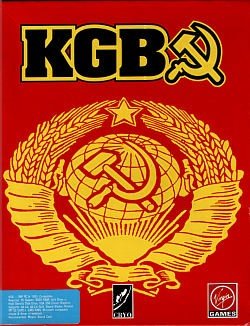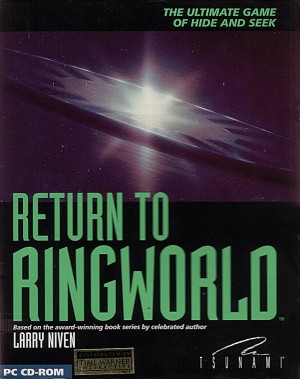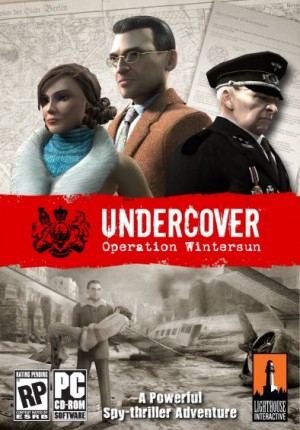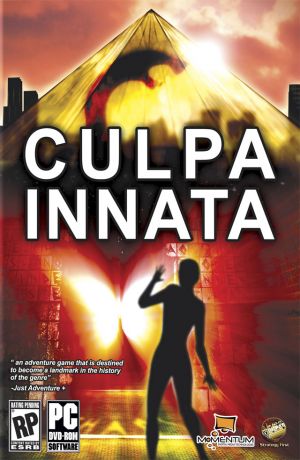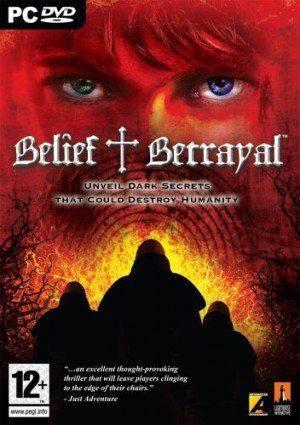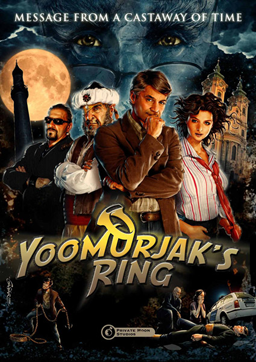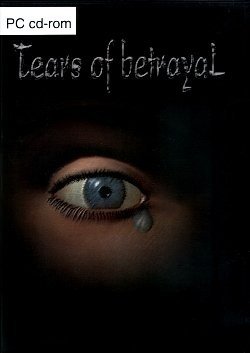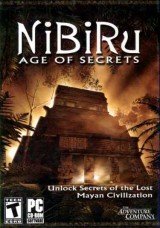Review for KGB

KGB starts with a bang.
Literally.
In a blood-red full motion video, an unknown assailant breaks into an office and guns down ex-KGB officer and alleged private eye Pyotr Golitsin as he works at his desk. The attack isn’t unexpected: Golitsin kept his own gun close at hand, but the precaution yields naught at the fatal moment. Soon after, Captain Maksim Rukov is summoned by his boss, Major Vovlov of KGB Moscow, and assigned to investigate the murder – specifically, to ascertain whether it’s linked in any way to Golitsin’s past employment with the KGB.
Cryo's KGB is a slideshow-style point-and-click adventure game that unfolds from Rukov’s perspective as his investigation sets him on the trail of an international crime ring exporting snuff video tapes – films of young women abused and murdered for real on screen – in exchange for cocaine smuggled in from Europe. But each clue he unravels draws him deeper into a conspiracy of powerful vested interests who crave not just illegitimate money, but the ultimate weapon – absolute political control – in a rapidly destabilizing nation.
It’s an interesting premise that is quickly lost in information overload. Set in 1991, the game entwines real events of the period into the story at an alarming pace that will leave gamers unfamiliar with the history of the Soviet Union (particularly the factors that led to its eventual collapse) in way over their heads. In a situation akin to being lost at sea – water everywhere, yet not a drop to drink – numerous characters and plot points vie for attention and explanation that isn’t forthcoming either from rookie Rukov or his contacts, who are always too busy to clearly state their agendas or answer his questions. Players thus have no choice but to plod along with Rukov through his mundane journey of inventory puzzles and tedious conversations amidst double- and triple-crosses to a contrived, haphazard end.
The eventual destination of the tapes is the USA, a lucrative market that represents the glittering ‘West’ to a sizeable chunk of the Soviet population chafing under the shackles of communism and desperately hungry for American dollars, Cuban cigars, and perestroika, then-President Mikhail Gorbachev’s promise of political and economic reforms intended to liberalize the government’s policies, end the Cold War, and improve the quality of life for the average Russian. But not everyone is excited about free trade and free speech. The opposition considers these revolutionary ideas a threat to the very essence of the Soviet Union, meticulously nurtured to reflect the supremacy of the state over individual rights and needs. These people – powerful leaders in the bureaucracy and the omnipotent KGB, as well as ordinary citizens – are alarmed by the growing influence of the West, spiraling costs of commodities, and rapidly-spreading anarchy across the nation.
After discovering a coded message indicating the time and place for the latest exchange of contraband, Rukov is dispatched to Leningrad to spy on the meeting, along with the warning to be wary of the local KGB, many officers of which are suspected to be pro-liberalization and corrupt. As expected, Rukov immediately faces quiet yet persistent resistance from the local operatives, who appear to be involved in crimes ranging from running prostitution rings to anti-government activities, leading one character to blandly remark that if all corruption was rooted out of the KGB, hardly any staff would be left. His advice? To focus on ‘relevant corruption’, that which poses a threat to the nation, rather than petty crime.
Rukov is aided in his investigation by his controller, the sadistic Savinkov; a mysterious entity called Cut-Throat; and a CIA operative who represents the American investigation into the case. The trail of the tapes leads Rukov from one dangerous situation to another – from seedy bars to dusty warehouses and swanky hotels, plus a trip out to the open sea in a rickety fishing boat to witness the actual ‘drop’. Originally released in 1992, the game earns its alternate title Conspiracy – the name it was re-released under in 1994 – as the case then twists again, veering wildly from straightforward crime to a more heinous political conspiracy to overthrow the liberal government and restore the Soviet Union to its conservative, communist glory.
Playing this game in 2010, nearly two decades after its creation and the fall of the Soviet Union, is like watching an eerie documentary of those turbulent years. Many issues are touched upon: the inherent distrust between the KGB and the Soviet militia; the derision between the various departments of the KGB; assassinations of people deemed to have ‘learnt too much’ and torture of civilians by the secret police; the scarring, decade-long war with Afghanistan; the emergence of aggressive ultra-national organizations such as the anti-Semitist Pamyat; the failed attempt by the KGB to overthrow Gorbachev; and the all-pervasive distress and misfortune of the common people. Unfortunately, the historical facts, though morbidly fascinating, prove to be the undoing of this game. They infringe on the story, needlessly complicate the plot, burden a protagonist too naïve to grasp their importance, disorient the gamer, and derail the premise of the smuggling ring which could have held its own if properly fleshed out.
The story is divided into four chapters, one set in Moscow and three in Leningrad. Rukov has to follow and talk to other characters to extract information about the case and current affairs. He can look at and use various objects in each scene and add some to his inventory, either to combine or apply later to external items. There is no pixel-hunting, the inventory is manageable despite harboring some useless junk, and the object use is limited and obvious. The default smart cursor decides the most obvious activity for each item, but players can choose additional actions like Hide, Fight, Listen and Knock by right-clicking on a hotspot. There is a map to help with orientation, though given the straightforward arrangement of locations, it’s never a real requirement.
Rukov has strict deadlines to achieve his tasks, which brings up the most interesting aspect of this game: it’s set in real time. His quest starts at 16:00 on August 13, 1991 (erroneously listed as ‘Wednesday’ on the splash screen – it’s a Tuesday), and the clock ticks in sync with the gamer’s own as Rukov travels between locations, interrogates allies and suspects, and gathers clues. Tasks must be completed and people met at the pre-set times, otherwise the events occur without Rukov’s presence and cause the mission to be aborted. And that’s not all that can abruptly end the investigation. KGB is realistic to a fault, focusing on procedure to the point of paralyzing decision-making. Rukov must navigate the virtual minefield in a particular order, largely by trial-and-error, and almost every move and dialogue can end the game with him either getting injured, captured, transferred to far-flung, undesirable locations, or simply dying. There are helpful options to restart the game, the chapter, or even rewind to just before the latest fatal decision point, but consequences of mistakes may be immediate or take hours to unfurl. The latter, when combined with the woefully-few four save slots, translates into countless wasted hours of retracing Rukov’s paths and replaying scenarios until the exact solution is worked out.
Sometimes the supporting characters give hints about the next course of action, such how to dispose of a body or a suspect revealing that he has claustrophobia. Even the game itself gives occasional nudges, highlighting a few key details to note or remember for later. But for the most part the gameplay is obtuse and tedious. The sole standalone puzzle requires decoding a message that is logically and visually near-impossible to grasp despite multiple clues given by a KGB contact (it mercifully has an auto-solve option), and is followed by a complicated route to enter and exit a warehouse multiple times with multiple fail clauses that will leave the average gamer with a headache. Many scenarios require Rukov to simply ‘wait’ using an on-screen hourglass that fast-forwards time until the next important event, but given that everything happens in real time, waiting at the wrong place can lead to missed cues elsewhere and – you guessed it – end the game.
KGB comprises a massive amount of dialogue, both relevant and irrelevant. The English is good and the text is free of typos, and even the casual chatter is an intelligent commentary on the socio-political climate of that time. Everyone, from hotel clerks to drunks in dirty alleys, has an opinion on just about everything. Conversations with KGB officers are either recitals of dedication to duty or veiled threats (mis)using offices of power, while the criminals cheerfully discuss business and pleasure alike. But while the game delves into painstaking depth about every minor character, including random passers-by, shockingly left out is Rukov himself. Though he has an interesting backstory, linked intrinsically to the main plot, he remains nondescript and devoid of personality, a mere tool used to interact with the game. He has no witty rejoinders or any opinion about the goings-on that give his perspective on the case, or even the situation in his country. Rarely has a central protagonist mattered so little to the big picture.
Though usually dark and often risqué, KGB does have its lighter moments. Ubiquitous use of the word ‘comrade’ is jibed at when Rukov talks gleefully about his childhood comic stash of Batcomrade, Supercomrade and Spidercomrade, while his office is stocked with copies of the Russian constitution, along with a treatise on ‘Why our constitution is the best’. Meanwhile, the CIA agent operates with the alias ‘Mickey Duck’, Rukov’s colleague Shevkova has an object of much envy – a typewriter in mint condition – thanks to her affair with big boss Galushkin, and dead bodies are described as such ‘permanently’ to squash any hopes optimistic gamers may have of resuscitating them.
The 640x480 pixel screens are richly-colored and nicely detailed, with realistic graphics and many small touches like posters on walls, debris on streets, extra characters and detailed furnishing indoors. Interactive hotspots blink, and conversation screens have animated close-ups of the characters, well-suited to their personalities. There is no in-game animation, however. The scenery is static, characters ‘dissolve’ in and out of screens, and cinematics are limited to the video at the start of the game. Musically, French composer Stéphane Picq’s incongruously cheerful electronica soundtrack keeps pace with Rukov as he races against the clock and the system, which is useful in the absence of sound effects and voice acting in the original release (voices were added to the Conspiracy CD-ROM re-release, including a cameo by Donald Sutherland as Rukov’s father).
Now a relic from the MS-DOS era, it should be noted that the PC version of KGB can only be played on modern versions of Windows via the DOSBox emulator. Also, like other adventure games of its generation, this too has a copy protection mechanism right at the start, which requires the player to key in the page number on which a particular image appears in the game manual.
Unfortunately, most gamers probably won’t find it worth the trouble anymore. Despite building up an extremely complex and convoluted story backed up by voluminous data, the game ends abruptly, leaving many questions unanswered, including the most important one of all. Crucial characters and plot points are summarily abandoned in a noticeable rush to close the case and end the game, almost as if the developers ran out of time. It’s a thoroughly unsatisfying end to an exhausting exercise. The incisive glimpse into the slice of history that forever changed the world’s largest nation certainly makes this game unique. However, if one wanted to learn history, a plodding, punishing adventure game would not be the reference of choice. KGB’s early potential and ambition are ultimately crippled by dull, pervasive seriousness and tiresome gameplay, and its biggest strength quickly morphs into its Achilles’ heel as the confounding story runs aground. When the ordeal ends, all the gamer is left with is relief and genuine regret at what could have been.


